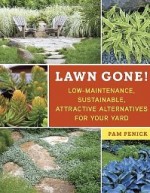 What is it about your lawn that you find so desirable? Whatever it is you may think differently about your lawn after you read Pam Penick’s book, Lawn Gone! The concept of lawns flowing through a neighborhood from one property to the next may be appealing but as Penick points out, lawns are unsuited to large regions of our country and are wasteful, expensive, and are not beneficial to wildlife. Good alternatives are available and Penick’s book shows you how to create an eco-friendly landscape from the removal of the old lawn to dealing the HOAs and designing a whole new landscape that will save you time and money without damaging environment.
What is it about your lawn that you find so desirable? Whatever it is you may think differently about your lawn after you read Pam Penick’s book, Lawn Gone! The concept of lawns flowing through a neighborhood from one property to the next may be appealing but as Penick points out, lawns are unsuited to large regions of our country and are wasteful, expensive, and are not beneficial to wildlife. Good alternatives are available and Penick’s book shows you how to create an eco-friendly landscape from the removal of the old lawn to dealing the HOAs and designing a whole new landscape that will save you time and money without damaging environment.
There are three major parts to the book. The first considers the different options for covering your yard such as low ground-covering plants, patios, paths, ponds, firepit or garden pavilion. Helpful before- and after-pictures and diagrams show how the possibilities can look. One of my favorites was a no-mow lawn of mixed fescues; the shaggy grasses asked to be touched.
The second section introduces you to the various methods of lawn removal and explains how to install hardscape and plant a new garden. The pros and cons of six different methods of removing grass from a lawn are discussed with specific suggestions for using each. General directions are given for installing hardscape such as paths, patios, decks, and water features and suggestions are included for preparing, planting, and maintain garden beds.
Unfortunately, property owners can not always do what they want with their lawn. Communities often have enforceable standards for front-yard landscaping, HOA’s have landscape rules, and neighbors can be skeptical and critical. Penick deals with these issues in section three suggesting ways of contending with both city hall and HOA’s as well as winning over neighbors. Other problems faced by lawnless home owners, such as four legged friends and fire are also treated.
At the end of the book, Penick provides plant and hardscape recommendations for eleven regions in the United States. This section has tremendous potential but unfortunately only included five plants for each region. This part of the book gives you some idea of the kinds of plants that would do well as lawn substitutes but should be expanded.
Lawn Gone! is a good introduction to switching from a traditional lawn to a low maintenance, sustainable yard with lots of pictures to encourage and inspire you to try a new approach. You will not get detailed directions but you will get a good idea of the scope of the endeavor so you can decide if the approach is for you. Ideas about lawns are changing and reading a book like this will help you embrace the change however quickly or slow you are able to accept it.